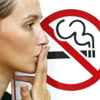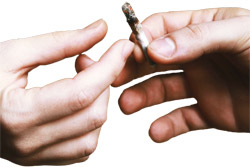- Disease burden
- Prevalence of smoking
- Smoking education and knowledge
- Quit statistics
- Economic impact of smoking
Disease burden
100 million people were estimated to have died from causes related to smoking in the 20th century. In other words, 100 million people who died unnecessarily from a preventable cause of death. This trend is continuing into the 21st century, with the World Health Organization estimating that 5 million people around the world die from smoking every year:
- China has 1.2 million smoking-related deaths annually – the most in the world.
- The worldwide death toll attributed to smoking is expected to reach 10 million per year by the 2020s.
- In 2003, tobacco-smoking was the second leading cause of disease burden in Australia (behind obesity) with 15,511 smoking-related deaths.
- 8% of disease and injury in Australia is attributed to tobacco smoking.
- In 2003, 20% of all cancer deaths were due to smoking. This includes 80% of lung cancer deaths which were caused by smoking.
- The younger a person is when they begin to smoke, the more likely they are to become dependent on nicotine and as a consequence, become heavy smokers at an increased risk of smoking-related health issues.
- Smokers report double as much psychological stress compared to non-smokers. Smokers report high or very high levels of psychological distress 20% of the time, compared to 10% in non-smokers. Smokers also tend to have a lower self-health rating than non-smokers.
- Smokers tend to be less healthy in other areas of their lifestyle than non-smokers. A national Australian survey in 2004 indicated that smokers:
- Eat less fruit and vegetables than non-smokers: 65% of smokers reported they do not consume the recommended intake, compared to only 39% of non-smokers;
- Exercise less than non-smokers: 77% of smokers reported they lived a sedentary lifestyle compares to 69% of non-smokers; and
- Consume more alcohol than non-smokers: 21% of smokers reported high levels of drinking compared to 16% of ex-smokers and 8% of non-smokers.
Tobacco smoke contains more than 4,000 different chemical compounds. At least 60 of these have been identified as carcinogens and 30 as metals, some of which are radioactive.
 |
For more information on smoking, its health effects and how to quit smoking, as well as some useful tools, videos and animations, see Smoking. |
Prevalence of smoking
- 6 trillion cigarettes are smoked each year.
- The most recent smoking prevalence statistics have confirmed that daily smoking rates are declining. In 2007, 16.6% of people over 14 years smoked daily, which is almost 3% less than the 19.5% of smokers in 2001.
- More adult males smoke than adult females – 18% and 15.2% respectively.
- The highest rates of smokers are found in the 18–24 age bracket amongst males, and the 25–34 bracket in females.
- From 12–17 years, 9% of boys and 10% of girls admitted to smoking in a survey conducted in 2005; these figures peaked at age 17.
- Indigenous Australians have the highest smoking rates in Australia ,with 50% of adults smoking daily in 2005; specifically, 51% of males and 49% of females. Not surprisingly, smokers within this population were more likely to report ill health than non-smokers.
- Manual labourers and factory workers have a higher incidence of smokers (almost 40%) than office workers and professionals (approximately 13%).
- People who have higher levels of education are less likely to smoke than those who finish school earlier.
- In 2004, about 92% of smokers reported themselves as daily smokers. The remaining 8% reported less frequent smoking patterns.
- In 2004, 37% of children under 14 lived in a house with one or more regular smokers. 10% of children lived in households where smoking was permitted indoors.
- People who are most socially disadvantaged are more likely to be smokers; 33% of men and 28% of women in the poorest areas are smokers, compared to 16% of men and only 11% of women in the wealthiest areas.
- People in major cities smoke less (22%) than in regional Australia (33%).
- 17.3% of pregnant women reported that they smoked at some stage during their pregnancy. This rate did not change significantly between 2002 and 2006.
Smoking education and knowledge
Some consumers cannot name a number of the major diseases caused by smoking. In recent Australian research, fewer than half the smokers realised that smoking causes stomach cancer (44%), and fewer than one-third of smokers accepted that pancreatic cancer (30%), gangrene (28%), kidney cancer (27%), bladder cancer (26%) and cervical cancer (23%) are illnesses caused by smoking. Almost one-fifth (18%) of smokers wrongly believed that the dangers of smoking had been exaggerated.
Quit statistics
In the past two decades, the number of Australians who have successfully quit smoking has substantially increased. A 2007 Australian survey found that there are more ex-smokers than smokers (aged 14 years or older) in Australia – 4.3 million and 3.1 million respectively.
- Only 8% of smokers in 2001 admitted to having no intention of ever quitting.
- The later in life the habit of smoking is developed, the easier it is to quit. That said, it is more common for younger people to make quit attempts.
- People who quit without any form of assistance or quit aids have a 3–5% rate of success, compared to 15–20% success for those who seek support.
- In an annual survey conducted in Victoria, smokers rated anti-smoking television commercials as the quit aid which had the greatest impact on their smoking cessation (46%), followed by nicotine replacement therapy (NRT) and other medications (21%), and advice from healthcare professionals (21%).
- 117,174 smokers phoned the Australian Quitline in 2007.
- Up to 90% of smokers think they should quit, but only 20% are committed to quitting at any one time.
- Research has indicated that NRT can increase the long-term quit rate by 50–70%.
- A recent study published in the United States estimated that if all smokers used NRT, at least 40,000 premature deaths due to lung cancer and cardiovascular disease could be avoided over 20 years. This figure is considered a moderate estimate, as it does not include premature deaths associated with any other cancer or lung disease.
 |
For more information on quitting smoking, see Strategies for Quitting Smoking. |
Economic impact of smoking
- From 1998 to 1999, tobacco accounted for 80% of total drug abuse healthcare costs, with 97,000 male and 45,000 female hospital admissions.
- In 2004, there were 149 deaths due to involuntary tobacco smoke exposure, including maternal smoking or exposure to second-hand smoke.
- Involuntary smoke exposure accounted for 63,667 hospital bed days in 2004, which cost $33.7 million. A staggering $30.6 million of this cost (90%) was due to involuntary smoke exposure illnesses in children under the age of 15.
- In 2004–2005, smoking cost Australia $31.5 billion dollars.
Profit from tobacco consumption
- 1,100 packs of 25 cigarettes are sold in Australia every minute!
- Approximately 2,000 people are employed in the three largest tobacco companies in Australia, which made a combined net profit after taxes of $586 million in 2007.
- In 2004, Australian tobacco sales accounted for 7% of all sales from supermarkets and grocers and 4.7% of all retail sales, estimated to be worth $9.3 billion.
- Cigarettes were the second largest product category in sales value in the Australian Grocery Industry in 2007.
- In convenience stores, cigarettes were the highest value product category, and other tobacco products such as cigars and roll-your-own tobacco were ranked ninth. In 2007, tobacco brands Winfield and Longbeach each generated an excess of $750 million in sales; this made them the top selling brand names of all grocery products alongside Coca-Cola.
References
- Worldwide smoking statistics [online]. Sans Souci, NSW: Think Quit; 2008 [cited 28 July 2010]. Available from: URL link
- Tobacco smoking in Australia: A snapshot, 2004-05 [online]. Belconnen, ACT: Australian Bureau of Statistics; 9 November 2009 [cited 10 August 2010]. Available from: URL link
- Smoking in Australia: Statistics [online]. Woolloomooloo, NSW: Cancer Council NSW; [cited 15 June 2010]. Available from: URL link
- Tar information sheet [online]. Fairbairn, ACT: quitnow, Australian Government Department of Health and Ageing; 14 February 2006 [cited 15 June 2010]. Available from: URL link
- Background brief: What’s in cigarettes? [online]. Carlton South, VIC: Quit Victoria; November 2003 [cited 10 July 2010]. Available from: URL link
- Tobacco [online]. Canberra, ACT: Australian Government Department of Health and Ageing; 11 March 2010 [cited 28 July 2010]. Available from: URL link
- Laws P, Hilder L. Perinatal statistcs series no. 22: Australia’s mothers and babies 2006 [online]. Bruce, ACT: Australian Institute of Health and Welfare, Australian Government; December 2008 [cited 19 September 2009]. Available from: URL link
- Lal A, Scollo M. The economics of tobacco control: 17.1 The economic rationale for intervention in the tobacco market. In: Scollo M, Winstanley M (eds). Tobacco in Australia: Facts and Issues (3rd edition) [online]. Carlton, VIC: Cancer Council Victoria; 2008 [cited 15 June 2010]. Available from: URL link
- Ellerman A, Ford C, Stillman S. Smoking cessation: 7.1: Quitting activity. In: Scollo M, Winstanley M (eds). Tobacco in Australia: Facts and Issues (3rd edition) [online]. Carlton, VIC: Cancer Council Victoria; 2008 [cited 15 June 2010]. Available from: URL link
- Ellerman A, Ford C, Stillman S. Smoking cessation: 7.7: Personal factors associated with quitting. In: Scollo M, Winstanley M (eds). Tobacco in Australia: Facts and Issues (3rd edition) [online]. Carlton, VIC: Cancer Council Victoria; 2008 [cited 15 June 2010]. Available from: URL link
- Ellerman A, Ford C, Stillman S. Smoking cessation: 7.17: Combined interventions. In: Scollo M, Winstanley M (eds). Tobacco in Australia: Facts and Issues (3rd edition) [online]. Carlton, VIC: Cancer Council Victoria; 2008 [cited 15 June 2010]. Available from: URL link
- Ellerman A, Ford C, Stillman S. Smoking cessation: 7.4: Assistance with quitting. In: Scollo M, Winstanley M (eds). Tobacco in Australia: Facts and Issues (3rd edition) [online]. Carlton, VIC: Cancer Council Victoria; 2008 [cited 15 June 2010]. Available from: URL link
- Ellerman A, Ford C, Stillman S. Smoking cessation: 7.14: Methods, services and products for quitting – Telephone advice and assistance. In: Scollo M, Winstanley M (eds). Tobacco in Australia: Facts and Issues (3rd edition) [online]. Carlton, VIC: Cancer Council Victoria; 2008 [cited 15 June 2010]. Available from: URL link
- Zwar N, Richmond R, Borland R, et al (eds). Smoking cessation guidelines for Australian general practice [online]. Fairbairn, ACT: quitnow, Australian Government Department of Health and Ageing; 2004 [cited 8 September 2010]. Available from: URL link
- Ellerman A, Ford C, Stillman S. Smoking cessation: 7.16: Pharmacotherapy. In: Scollo M, Winstanley M (eds). Tobacco in Australia: Facts and Issues (3rd edition) [online]. Carlton, VIC: Cancer Council Victoria; 2008 [cited 15 June 2010]. Available from: URL link
- Apelberg BJ, Onicescu G, Avila-Tang E, Samet JM. Estimating the risks and benefits of nicotine replacement therapy for smoking cessation in the United States. Am J Public Health. 2010;100(2):341-8. [Abstract]
- Winstanley M. The tobacco industry in Australian society: 10.2: The manufacturing industry in Australia. In: Scollo M, Winstanley M (eds). Tobacco in Australia: Facts and Issues (3rd edition) [online]. Carlton, VIC: Cancer Council Victoria; 2008 [cited 15 June 2010]. Available from: URL link
- Winstanley M. The tobacco industry in Australian society: 10.4: The tobacco companies operating in Australia. In: Scollo M, Winstanley M (eds). Tobacco in Australia: Facts and Issues (3rd edition) [online]. Carlton, VIC: Cancer Council Victoria; 2008 [cited 15 June 2010]. Available from: URL link
- Winstanley M. The tobacco industry in Australian society: 10.3: Retail value and volume of the market. In: Scollo M, Winstanley M (eds). Tobacco in Australia: Facts and Issues (3rd edition) [online]. Carlton, VIC: Cancer Council Victoria; 2008 [cited 15 June 2010]. Available from: URL link
All content and media on the HealthEngine Blog is created and published online for informational purposes only. It is not intended to be a substitute for professional medical advice and should not be relied on as health or personal advice. Always seek the guidance of your doctor or other qualified health professional with any questions you may have regarding your health or a medical condition. Never disregard the advice of a medical professional, or delay in seeking it because of something you have read on this Website. If you think you may have a medical emergency, call your doctor, go to the nearest hospital emergency department, or call the emergency services immediately.

 Worldwide
Worldwide In the past two decades, the number of Australians who have successfully quit smoking has substantially increased. A 2007 Australian survey found that there are more ex-smokers than smokers (aged 14 years or older) in Australia – 4.3 million and 3.1 million respectively.
In the past two decades, the number of Australians who have successfully quit smoking has substantially increased. A 2007 Australian survey found that there are more ex-smokers than smokers (aged 14 years or older) in Australia – 4.3 million and 3.1 million respectively. Healthcare costs
Healthcare costs





